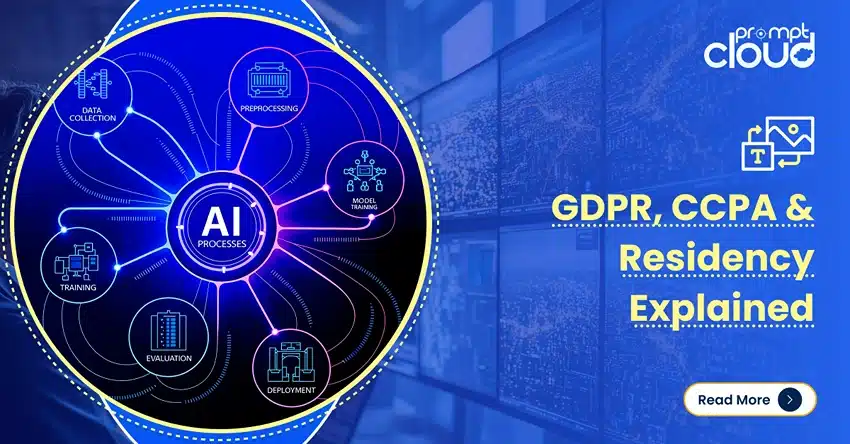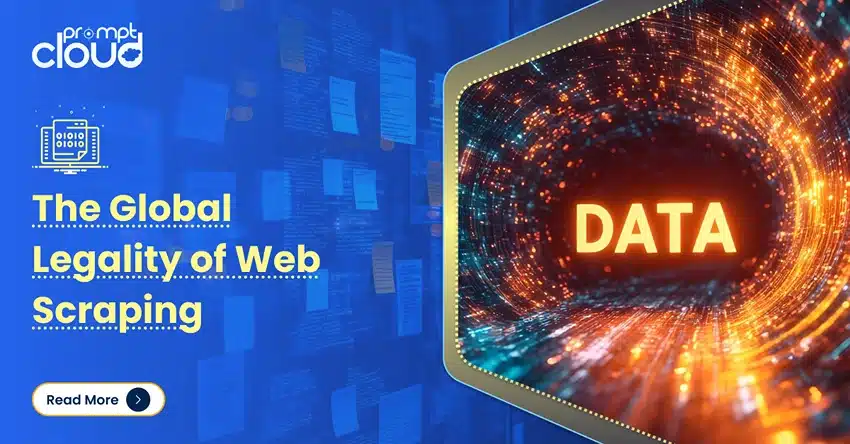
**TL;DR**
Scraping Google might sound like a good starting point for collecting data, but it often leads to more problems than solutions. Here’s what this article will cover:
- What “scraping Google” really means and why it’s not the same as accessing structured web data.
- Why search result data is unreliable, inconsistent, and often blocked by Google’s systems.
- How vague data goals lead to scraping mistakes, and why clarity matters.
- What you should be doing instead- targeting specific websites based on your actual data needs.
- How web scraping service providers like PromptCloud help businesses get clean, useful data from the right sources, ethically and at scale.
Why So Many Startups Start with “Scraping Google”
It’s common for startups and early-stage businesses to think about scraping Google when they first explore large-scale data collection. On the surface, it makes sense. Search engines show all kinds of results, links to prices, articles, job listings, product reviews, and more.
That volume gives the impression that everything you need is right there, ready to be pulled. But once teams try it, they usually realize it’s not that simple.
Search results aren’t built for data extraction. They change often, lack structure, and don’t always point to the source. More importantly, scraping Google directly can cause problems. It doesn’t scale well, and in many cases, it goes against the platform’s rules.
This article breaks down what scraping Google involves, why it tends to fall short, and how focusing on the right sources, actual websites, leads to better, more useful data for your business.
What Does “Scraping Google” Mean?
A lot of teams say they want to scrape Google when they first start thinking about web data. What they usually mean is pulling information from search result pages—titles, links, maybe short descriptions that appear after a quick search. It seems like an easy way to get started. But it doesn’t work that way.
Google doesn’t create that data, it just points to where it lives. It’s more like a map. What you see on the search results page is just a set of directions pointing to other sites. You’re not getting full product listings, detailed content, or structured information. You’re just collecting surface-level blurbs.
Say you’re in e-commerce, and you want pricing data for products across ten different retailers. You search for “best wireless headphones under $100” and think—why not scrape these results? But all you’ll get is a mix of blog posts, category pages, and maybe some Google Shopping links. It won’t tell you exact prices, inventory levels, or if the product is available in blue. For that, you need to pull data directly from the retailers’ sites, where that information lives.
That’s where the gap shows up. Teams think they’re building something scalable, but scraping Google is unstable. The results change often, vary by location, and may even differ depending on who’s searching. And scraping them? Google’s systems are built to spot and block that kind of activity.
In the end, when someone says they want to scrape Google, they often haven’t defined their actual data need yet. Once that’s clear, it becomes obvious that the search page isn’t the place to start.
Why Scraping Google Isn’t a Sustainable Data Strategy
It’s common for businesses to start with Google when thinking about data collection. You search for something, see a long list of results, and it feels like you’ve already found the data. But when you try to use that list for actual business decisions, things stop working as expected.

Search Results Are Inconsistent and Always Changing
Search engines don’t show the same results every time. You could run the same search twice in one day and get two different sets of results. Sometimes the pages change. Other times, it’s the order that shifts. Some listings drop off completely. What you see can also vary based on your location or the device you’re using.
This makes it hard to collect reliable data over time. You can’t track patterns if the input keeps changing.
There’s No Real Structure in the Data
Search results don’t follow one format. One result might take you to a blog post. Another could lead to a product page or even a discussion thread. There’s no real pattern. Each link shows different types of content, with different layouts and varying levels of detail.
If you’re hoping to turn this into a spreadsheet or use it to compare data points, it becomes messy fast. There’s no shared structure across the results, which means more manual work or unusable output.
Google Blocks Scrapers Aggressively
Try to scrape Google with a tool or script, and you’ll likely hit a wall. Their systems are designed to detect automated behavior. You’ll run into CAPTCHAs, get temporary blocks, or stop getting real results at all.
Some teams try to get around this by rotating IPs or slowing down requests. But these workarounds don’t hold up for long. The process becomes more about keeping the scraper running than working with actual data.
Scraping Google Goes Against Their Terms of Service
It’s right there in Google’s policies: automated scraping of their search pages isn’t allowed. That alone makes it a risky approach. For companies in finance, healthcare, or any regulated space, ignoring those terms can lead to bigger problems.
Even outside of compliance, building something that depends on a blocked method usually ends up being more fragile than expected.
The Real Problem: Lack of Clarity on Data Goals
A big reason people end up trying to scrape Google is because they haven’t really nailed down what they’re looking for yet. It feels like a good place to start—type in a broad search, get a list of results, and maybe something useful turns up. It’s not that unreasonable. But that usually means the strategy is still taking shape.

“More Data” Isn’t the Same as Useful Data
When the goal isn’t clear, the fallback tends to be volume. People collect hundreds or thousands of links, thinking that something in there must be valuable. But those lists? They’re often just headlines and summaries. No full product info, no pricing, no actual entries. You’re left holding links that still need to be scraped one by one—or ignored altogether.
This happens often with new teams. They want to move fast, maybe test an idea, but they skip the step where they figure out exactly what they need. Without that, it’s easy to mistake quantity for progress.
Google Becomes a Shortcut for Unfocused Strategy
It’s common to treat search results like a pre-made dataset. The logic is simple: if Google can find it, we can scrape it. But that’s not how search engines work. They show what might be relevant, not what’s structured or complete. So when teams rely on Google to find their data, they’re putting their workflow in the hands of an algorithm they don’t control.
Instead of choosing five solid sources, they end up scraping fifty weak ones. It looks like progress, but it’s a lot of noise.
Start with the Questions You Want the Data to Answer
Most of this clears up once there’s a defined outcome. Say you need to track room prices across hotel sites. That goal points directly to a handful of booking platforms. Or maybe you’re building a lead list—then you’re likely looking at business directories or company websites.
Once you know what the data is for, the right sources usually become obvious. And at that point, scraping Google starts to feel like a detour instead of a solution.
What You Should Do Instead: Structured and Intentional Web Scraping
Scraping Google might seem like the easiest way to jump into web data. But in most cases, it doesn’t hold up. A better starting point is knowing what kind of data you need and which sites have it. That makes the whole process clearer and more useful.
Start with Specific Websites, Not Search Engines
Let’s say you’re monitoring hotel prices, tracking used car listings, or collecting product reviews. In each case, the real information is on the source websites—travel portals, car marketplaces, or e-commerce stores. Not in Google’s search pages.
Scraping these websites directly gives you cleaner, more relevant data. You can pull product names, prices, ratings, availability, and even timestamps. That’s not something a search result page will give you, no matter how deep you scrape it.
Structure Matters More Than Volume
A huge mistake teams make is thinking that more links mean more data. But when you scrape 1,000 disorganized results, you don’t just get more info, you get more cleanup. Scraping directly from a well-structured site like an online marketplace or job board often gives you fewer records, but with way more accuracy and context.
It’s not about how much data you grab, it’s about whether that data answers the questions you set out to ask.
Custom Scraping Means Cleaner Workflows
If you know exactly which sites you need data from, your tools can be designed around them. Scrapers can be built to match the layout of each site, which cuts down on errors and makes the process easier to manage. Updates are more straightforward, and the output fits better into whatever system you’re already using.
This is the kind of work web scraping service providers take on. They work with you to narrow the scope, figure out how the data should be pulled, and make sure what you get is useful from day one. You’re not left fixing broken scripts or sorting through irrelevant pages.
Scraping Google vs. Scraping Targeted Websites
| Aspect | Scraping Google | Scraping Targeted Websites |
| Source of Data | Search results (titles, snippets, URLs) | Actual data from content-rich source websites |
| Data Quality | Incomplete, inconsistent, and often outdated | Structured, direct, and relevant to business needs |
| Structure & Format | Unstructured; varies across results | Structured based on website layout and data model |
| Use Case Fit | Rarely usable without heavy filtering or follow-up crawling | Aligned with specific goals like pricing, job listings, reviews, etc. |
| Stability | Results change frequently, influenced by location, history, and algorithm updates | More stable and predictable, especially with consistent layouts |
| Scalability | Difficult to scale; heavy blocking and rate limiting from Google | Easier to scale with site-specific crawler logic and monitoring |
| Compliance | Often violates Google’s Terms of Service | Can be compliant when following site rules and ethical scraping practices |
| Maintenance | Breaks easily; Google actively resists scraping | More manageable with targeted monitoring and scraper updates |
| Setup Complexity | Superficially simple, but high failure rate and low data usability | Requires planning, but offers better long-term reliability |
| Best Used For | Proof-of-concept experiments (short-term) | Production-ready, long-term data collection and integration |
How PromptCloud Helps with Custom Web Scraping
Getting useful data often comes down to choosing the right source. That’s what PromptCloud focuses on: helping you collect data from websites that publish the information you care about. We don’t scrape search engines. We go straight to the source.

We Focus on the Data You Need
Some people come to us with a specific goal, like collecting prices for a few categories of products across retail sites. Others aren’t sure where to begin but know they need clean, reliable data for analysis.
Whether the goal is clear from the start or not, the first thing we look at is the purpose. What are you trying to learn or track with this data? Once that’s nailed down, we look at where the data lives, which sections are relevant, and how often it needs to be collected.
No More One-Size-Fits-All Scraping
When a site has a clear layout, we can extract only what’s useful. This might be product names and stock levels, job listings with location tags, or even review counts and ratings.
Since each client has a different need, every setup is built separately. There’s no generic scraping engine pulling everything from everywhere.
Built-in Compliance and Ethics
We don’t take data from places that don’t allow it. Some sites block scraping completely or use heavy restrictions. In those cases, we don’t push through. We follow site rules and keep things within what’s allowed.
There’s no point in building a system that works one day and breaks the next. We aim for long-term reliability.
(You can also see what we don’t scrape.)
Scalable, Hands-Off Infrastructure
Once the setup is live, we handle the backend. That includes keeping up with layout changes, rate limits, and delivery schedules.
We send the data in formats that are easy to work with. Most clients choose JSON or CSV, but other formats can work too. Files can be pushed to cloud storage, FTP, or through APIs, depending on what’s easiest for you.
Support That Solves Problems
If something stops working, we look into it. If a site changes, we adjust. You won’t be stuck managing errors or patching scrapers every week.
This isn’t a self-serve tool where you’re left alone after signing up. We’re available when something needs attention, and that includes both tech and data questions.
Don’t Scrape Google, Scrape with Purpose
It’s easy to think Google is the right place to start when you need web data. That’s where most people begin when they’re looking for anything online. But search results are made for users, not machines. They shift constantly, follow no clear structure, and don’t offer access to the data behind the links.
If the goal is to build something reliable, whether that’s a live dashboard, a price tracker, or a research dataset, the better option is to go straight to the source. Scrape websites that hold the information you need, not the search engine that lists them.
This approach isn’t just more accurate. This approach holds up better over time. You decide what gets collected, in what format, and on what schedule. When the setup follows site guidelines and avoids aggressive crawling, you’re less likely to run into problems later on.
At the end of the day, scraping with a plan, based on real data needs, is a far better strategy than scraping blindly from search results. It’s not about collecting everything. It’s about collecting the right data. Schedule a demo with us today!
FAQs:
1. Is it legal to scrape Google search results?
Not exactly. Google doesn’t allow automated tools to collect data from its search pages. It’s written in their terms. Trying to do it anyway often leads to being blocked or getting incomplete data. For most companies, it’s not worth the risk.
2. Can’t I just get all the data I need from search results?
Search pages show you links, not the data itself. If you need product info, prices, reviews, or other details, you’ll still have to visit the actual websites. Scraping search results might seem fast, but it usually creates more work.
3. What’s the alternative to scraping Google?
It’s better to pull data from the actual source. If you need product information, go to the retailer’s site. For job listings, check the company’s career page. This cuts out extra steps and gives you cleaner data that’s easier to work with.
4. Why work with a web scraping service provider?
They help you avoid the trial and error. Instead of figuring everything out from scratch, you get a setup that fits your use case, works with your systems, and adapts if something breaks. It also saves a lot of time.
5. How do I know which sites to scrape?
You don’t need to start with a list of websites. Start with what you want to track—maybe product listings, job posts, or prices. Once that’s clear, the sources become easier to spot. If you’ve never done it before, getting advice from someone who has worked with web data helps avoid guesswork.



















